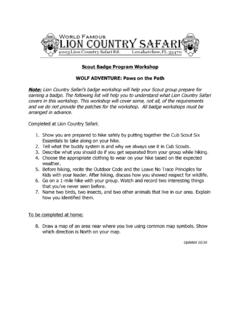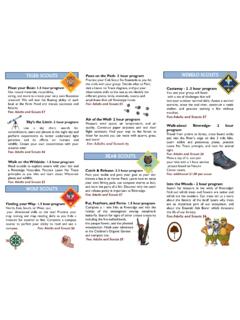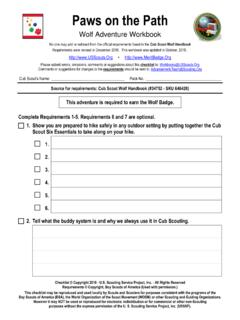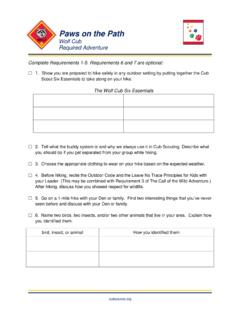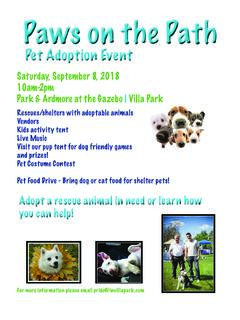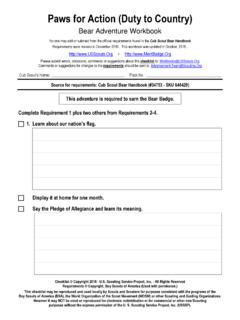Transcription of Wolf Den Paws on the Path, Adventure Requirement #6 ...
1 Wolf Den Paws on the path , Adventure Requirement #6 Finding Your Way, Adventure Elective Your walk is based on the 1926 Sanborn map. These maps were done every six to ten years to plot the buildings in a town for assessing fire insurance liability. We are going to talk about some of the businesses that were here. We recommend having the boys use a compass to help them learn north, south, east, and west. You can also teach them to calculate their pace to help them determine the distance ( ) You will be starting at the First Evangelical Lutheran Church, on the Market Street side. Look across (south) the street. Do you see the white church building? There were two churches (two denominations) using the same church building, but in 1858, they decided to separate and build separate churches. The Lutheran congregation built the red brick building (behind you) and the United Church of Christ congregation built the white building. You will see the building they shared at the end of the walk.
2 Turn east and begin walking, about 250 feet. While this building is now the Providence Orthodox Presbyterian Church, it began as St. Paul s, an early Methodist Church. Before that, this site was a tannery, where leather goods were made. Underneath the rear of the church building, there are still tanning vats. Walk east another 150 feet. On your side of the street (the north side), in what is now the parking lot was the Franklin School. Originally if your parents wanted you to be educated, they would pay tuition to a subscription school. Sometimes, the school was owned and operated by one teacher. The Franklin School was a subscription school where classes were taught in English. By 1926, the Franklin School had reverted to a private residence, but it was later torn down to make a parking lot . Continue east for another 200 feet, turning north (onto 3rd Street). Travel north 500 feet (to Mifflinburg Hotel/Scarlet D). When Mifflinburg was founded in 1797, one of the first structures built was an inn where travelers could stay.
3 By the 1850s, Mifflinburg had four hotels along the main street (Chestnut Street). The Mifflinburg Hotel building was built in 1858 as the Deckard House. By 1926, it was called the Hotel Hopp and was the only hotel operating in town. The Hopp family was very wealthy, owning many properties in town and acting as landlords. Travel north on 3rd Street for about 528 feet to Bing s Auto on Mulberry Street. In 1926, the business that was located here was Snyder s Coal and Lumber Yard. They came before Klose s Oil in providing heating to residents and Mifflinburg Building and Lumber in providing building materials. Before it was Snyder s, this site belonged to Albright s Agricultural Implements, which made plow blades, seeders and more. Travel south on 3rd Street to the Rail Trail and then turn west and walk along the Rail Trail to 4th Street, about 1000 feet. The Buffalo Valley Rail Trail was installed in the old railroad bed. The Pennsylvania Rail Road (PRR) tracks were first laid through Mifflinburg in 1871.
4 The train allowed businesses to bring parts, supplies, and merchandise into town; send finished products to customers far away; and send agricultural products to larger markets. Just north of the rail road tracks at 4th Street was the Kurtz Brothers Overall Factory. Kreider and Newton Kurtz went into business in the 1880s on Chestnut Street, but as their business grew, they purchased a larger factory to make denim overalls, shirts, aprons and ship them all over the country. Kurtz Brothers was the largest employer of women in town. Turn south on 4th Street and travel about 500 feet to the corner of 4th and Walnut. The lot on the northeast corner of 4th and Walnut was the home to many businesses before becoming the apartment house you see today. The first business was Sankey s Tannery where they made Sankey s leather oil, then Kreider and Newton Kurtz father, Luther owned a tannery here. In 1903, Alfred Hopp (who later owned the Hotel Hopp) built this brick building which he used to make buggies until 1922.
5 In 1926, this building was the home to the Mutual Stock Food Company, which made feed for horses, cows, pigs and chickens. The building next door (to the east) was the home of the Mifflinburg Buggy Company. Just one year later (June, 1927), a fire broke out in the Buggy Company building which was not being used at the time. The fire destroyed much of the buildings leaving only what you see today. Travel south on 4th Street, stopping at the Post Office. If you take the walk during the day, take a moment to go into the Post Office to look at the Depression Era murals in the lobby. There is a newspaper article in the case along the north wall. If not proceed to Chestnut Street. Turn west towards 5th Street. As you walk along Chestnut Street, notice some of the buildings. On the corner at 400 Chestnut in 1926, there was a bank (Farmer s Bank). At 408, was the Post Office with the Mifflinburg Telegraph, the town s weekly newspaper, on the second floor. Farther down the street (434) was the movie theater.
6 In 1926, the original owners, Kitty and Fish Romig sold the building to Charlton Theaters of Milton. It reopened in May, 1926 with the name, New Theater and the admission price of 10 for children and 25 for adults. At the corner of 5th and Chestnut was Gutelius Grocery Store. Turn south, cross the street and proceed south to Market Street, then continue onto Green Street, it will be about 1000 feet. Although the Library (at the corner of 5th and Market) is here now, in 1926, the Herr family home was still that, a family home. On the south west corner was the German School House. If you remember when we first started, we talked about the school were classes were taught in English. At the German School House, classes were taught in German. This is still before public schools. If you look south, you will notice the Elias Center for Performing Arts. This was the joint church building of the Lutheran and United Church of Christ, which was built in 1806. Turn east and travel along Green Street.
7 At the north east corner of the 5th and Green was the Gutelius House. The house was built in 1803, and in 1926, a Gutelius descendent was still living there. As you travel east, you will come to 406 Green Street. Notice the plaque on the building. This was built as the first courthouse for Union County, but in 1926 it was a family home. When you reach the corner of Green and 4th Street, notice the Y in the road. To the west was Youngmanstown, as that half of the town was originally known, to the east was Greenville or Rotestown. Each half was named after the man who founded that half. Mifflinburg was officially named in 1827. If you look south, notice the cemetery. On the east side of the street was the location of the second public school in town. (The first public school was located where the Buggy Museum s Visitor Center is today). Turn north and travel along 4th Street to Market, then east to the Lutheran Church and you are finished.

